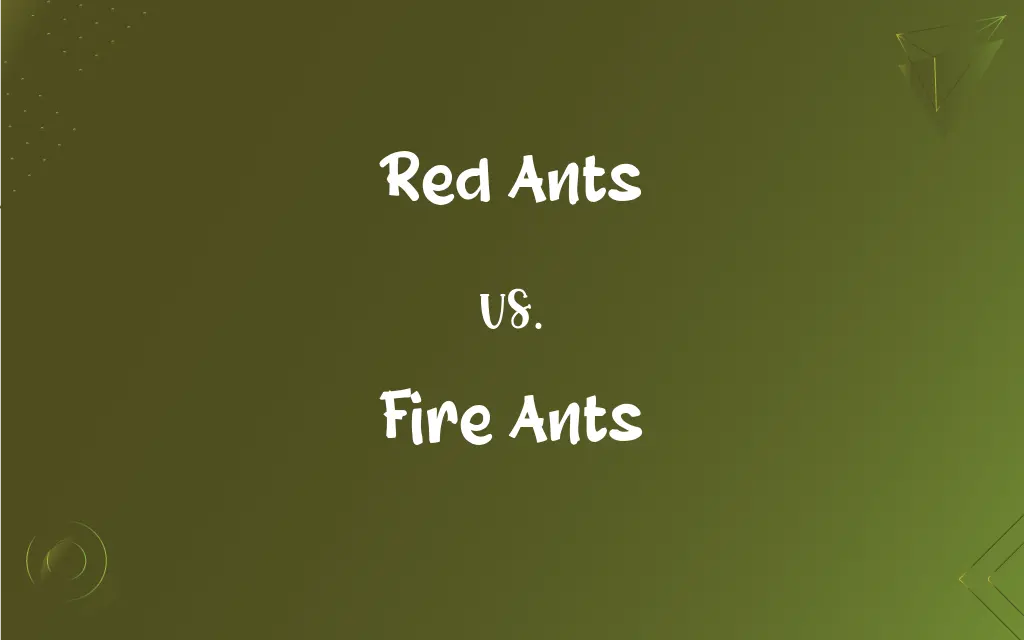Red Ants vs. Fire Ants: What's the Difference?
Edited by Aimie Carlson || By Harlon Moss || Updated on October 20, 2023
Red ants refer to various ants with a reddish hue, while fire ants are a specific aggressive species known for their painful sting.

Key Differences
Red ants and fire ants both carry a red hue, which often leads to confusion. Red ants is a general term that encompasses several ant species that possess a reddish-brown color. These ants can vary in behavior, habitat, and other characteristics depending on the specific species. On the other hand, fire ants are a particular group within the ant genus Solenopsis and are known for their aggressive behavior and potent sting.
While red ants might refer to any ant species with a reddish appearance, not all red ants are fire ants. The term "red ants" does not denote any specific behavior or habitat. Some red ants might be harmless or even beneficial for certain ecosystems. Conversely, fire ants are notorious for their aggressive defense of their nests and their ability to deliver a painful sting, which can cause allergic reactions in some individuals.
Red ants, being a broad category, can be found in various environments, from gardens to forests, depending on the specific species. They play diverse roles in the ecosystem, ranging from scavengers to predators. Fire ants, specifically, prefer open, sunny areas and are often found in grassy fields, lawns, and parks. They build large mound-like nests and can disrupt local ecosystems due to their aggressive nature and rapid reproduction.
Both red ants and fire ants have a role in their ecosystems, but it's the fire ants that often come into conflict with humans. Their painful sting, aggressive behavior, and tendency to invade open areas like gardens and lawns make them a significant concern in infested regions. In contrast, red ants, unless they belong to the fire ant species, might not always be a cause for concern and can even be beneficial in controlling pests.
In conclusion, while the terms red ants and fire ants might seem interchangeable due to their color, they refer to different classifications. Red ants is a general term for ants with a reddish hue, whereas fire ants denote a specific aggressive species known for their painful sting.
ADVERTISEMENT
Comparison Chart
Definition
General term for ants with reddish coloration
Specific species known for painful stings
Behavior
Varies by species
Aggressive, especially when nests are disturbed
Habitat
Diverse, depending on species
Open, sunny areas like lawns and fields
Sting
Not all have painful stings
Known for painful, burning stings
Role in Ecosystem
Varies; from scavengers to predators
Can disrupt local ecosystems due to aggression
ADVERTISEMENT
Red Ants and Fire Ants Definitions
Red Ants
A term for ants with reddish-brown coloring.
The garden is infested with red ants.
Fire Ants
Typically build mound-like nests.
You can identify fire ants by the mounds they build.
Red Ants
Role in the ecosystem can be diverse.
The red ants in my garden help control pests.
Fire Ants
Can cause allergic reactions in some individuals.
He had to see a doctor after a fire ants sting caused swelling.
Red Ants
Not specific to any one species.
I'm unsure which species these red ants belong to.
Fire Ants
Prefer open and sunny habitats.
The playground is infested with fire ants due to its sunny location.
Red Ants
Can be found in multiple habitats.
Red ants thrive in both gardens and forests.
Fire Ants
A specific genus of aggressive ants.
Fire ants invaded our picnic.
Red Ants
Vary in size and behavior.
These red ants seem to be larger than the ones I saw last week.
Fire Ants
Known for their painful sting.
Be careful of fire ants; their sting hurts.
FAQs
Are fire ants native to the U.S.?
No, fire ants were introduced to the U.S. and are considered invasive in many areas.
Why are fire ants called so?
Fire ants are named for their painful sting, which feels like a burn.
Can I have an allergic reaction to a red ant sting?
It's possible, especially if the red ant is a fire ant species.
How do fire ants affect the environment?
Fire ants can disrupt local ecosystems, outcompeting native species and preying on native fauna.
How fast do fire ant colonies grow?
Fire ant colonies can grow rapidly, with a mature queen producing up to 1,500 eggs per day.
What attracts fire ants to lawns?
Fire ants are attracted to open, sunny areas and can be drawn to food sources in lawns.
How can I prevent fire ant stings?
Avoid disturbing their mounds and wear protective footwear in infested areas.
Are fire ants aggressive?
Yes, fire ants are known for their aggressive behavior, especially when their nests are disturbed.
Are there different species of fire ants?
Yes, there are multiple species within the fire ant genus, Solenopsis.
Are all red ants fire ants?
No, not all red ants are fire ants.
How can I identify a fire ant mound?
Fire ant mounds are usually large, dome-shaped, and lack a central entrance.
Are red ants and fire ants the same size?
No, the size varies; fire ants are typically smaller than many red ant species.
Can red ants be found indoors?
Some red ant species can invade homes in search of food.
Can red ants sting?
Some red ants can sting, but not all have a painful sting like fire ants.
Do red ants benefit the ecosystem?
Yes, red ants play various roles, from scavengers to predators, benefiting ecosystems.
How can I get rid of fire ants?
Multiple methods, from bait to direct mound treatments, can help control fire ants.
Do red ants bite or sting?
Some red ants bite, some sting, and some do both, depending on the species.
What do red ants eat?
Diet varies by species; they can eat seeds, insects, sweets, and other food sources.
Why are fire ants considered problematic?
Due to their aggressive nature, painful stings, and disruption to local ecosystems.
Where did fire ants originate?
Fire ants are native to South America.
About Author
Written by
Harlon MossHarlon is a seasoned quality moderator and accomplished content writer for Difference Wiki. An alumnus of the prestigious University of California, he earned his degree in Computer Science. Leveraging his academic background, Harlon brings a meticulous and informed perspective to his work, ensuring content accuracy and excellence.
Edited by
Aimie CarlsonAimie Carlson, holding a master's degree in English literature, is a fervent English language enthusiast. She lends her writing talents to Difference Wiki, a prominent website that specializes in comparisons, offering readers insightful analyses that both captivate and inform.































































